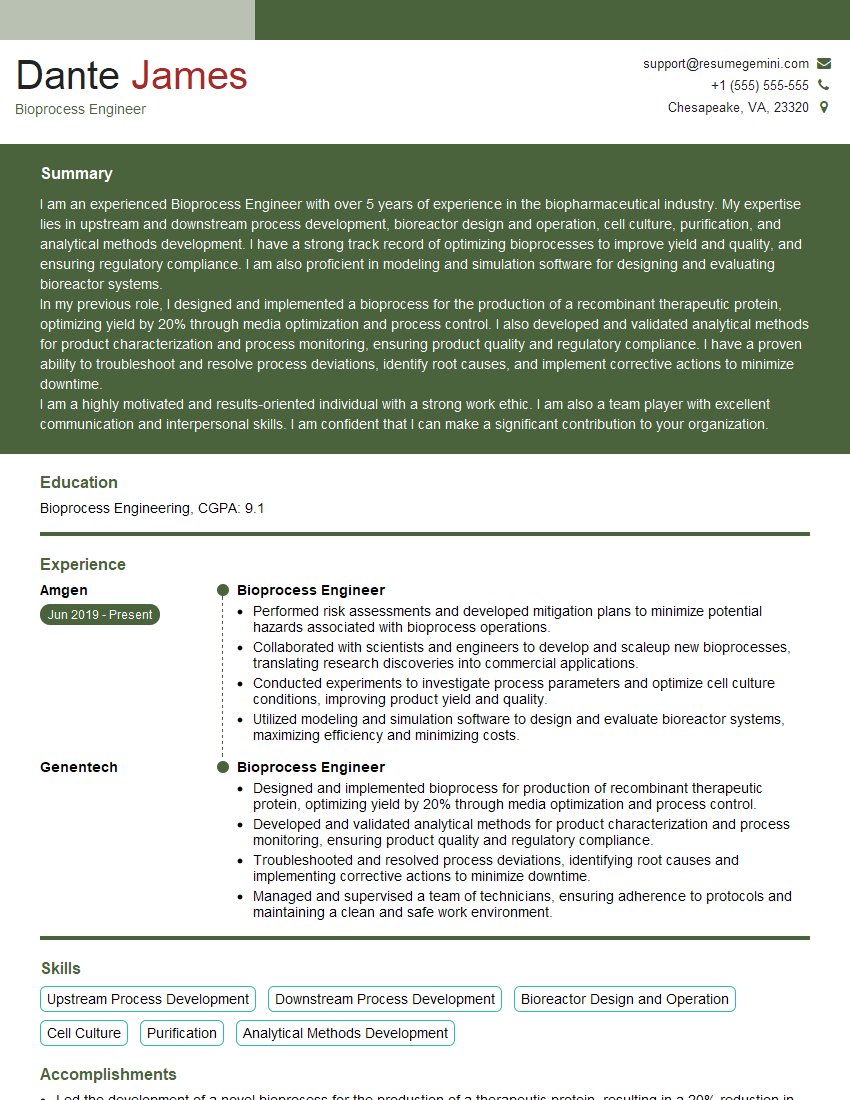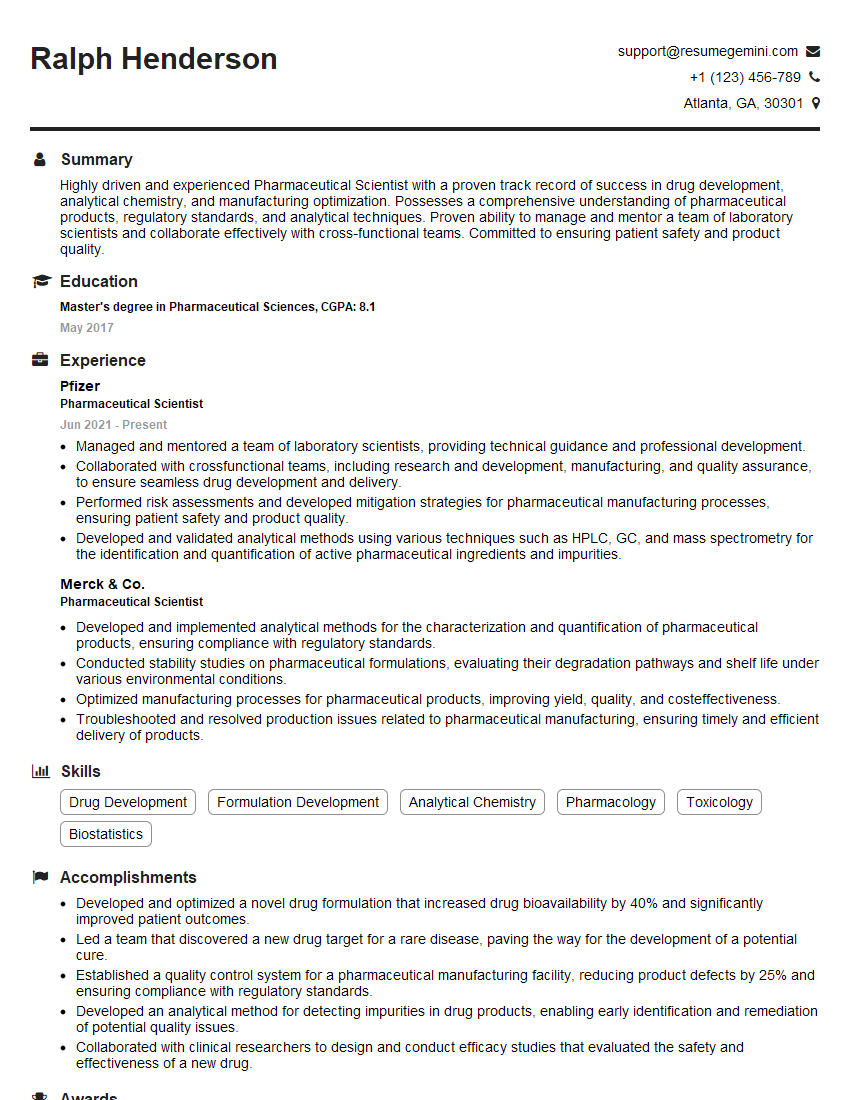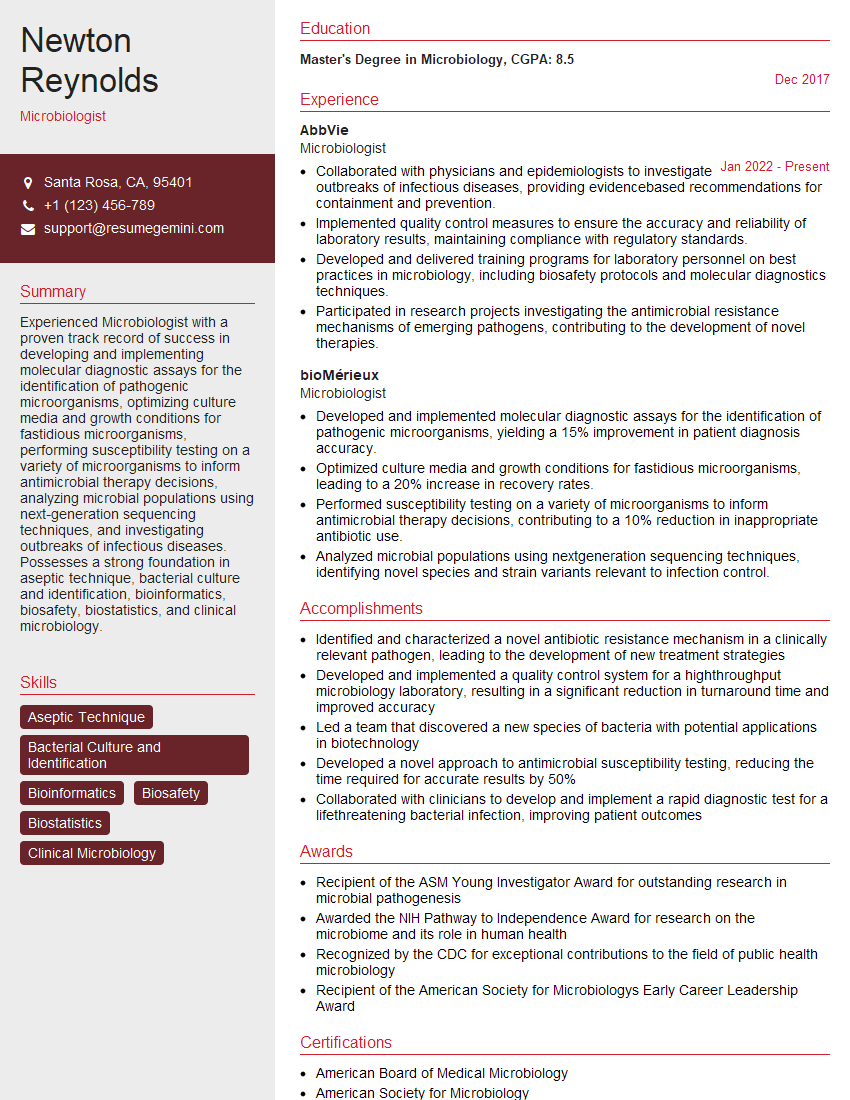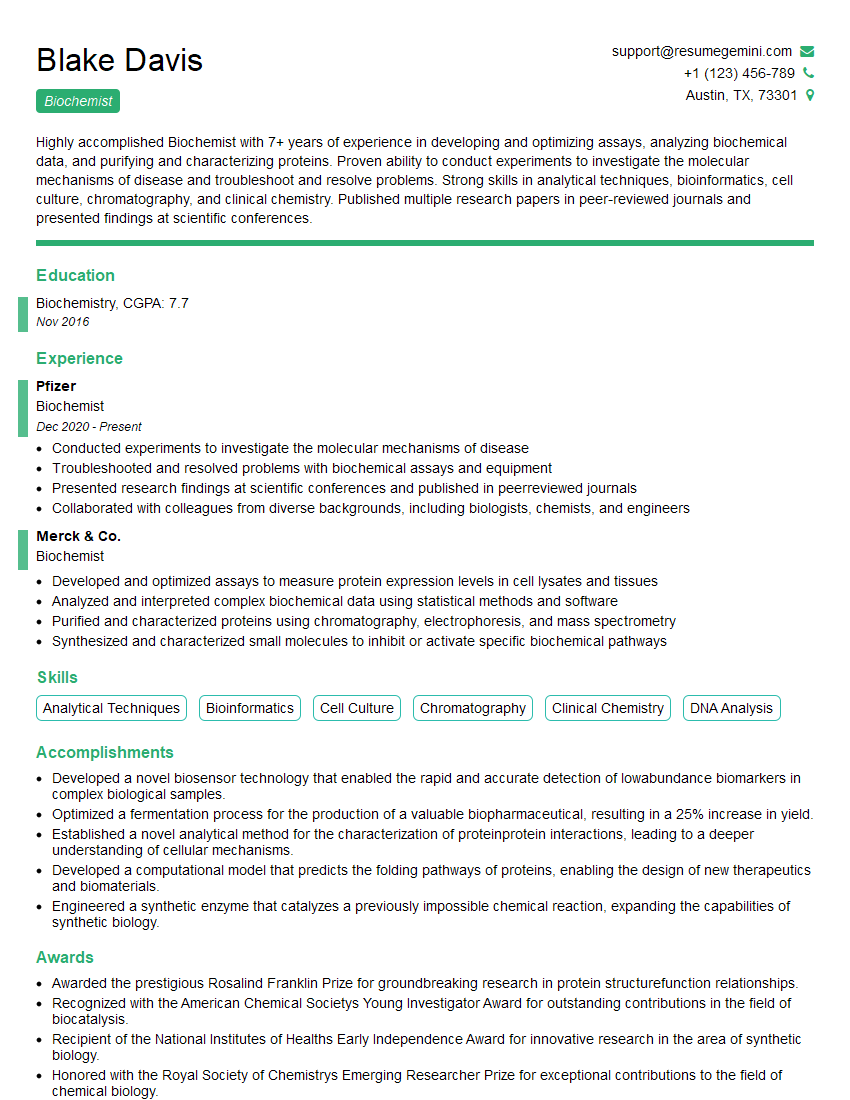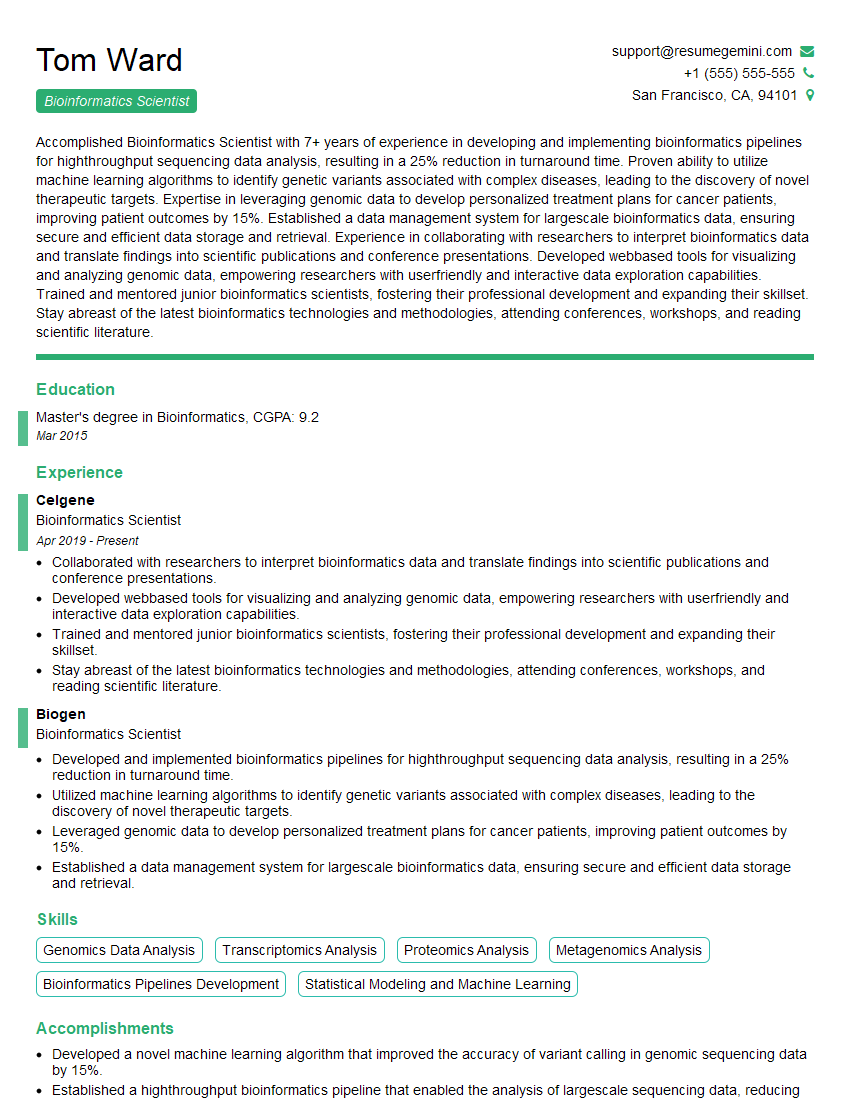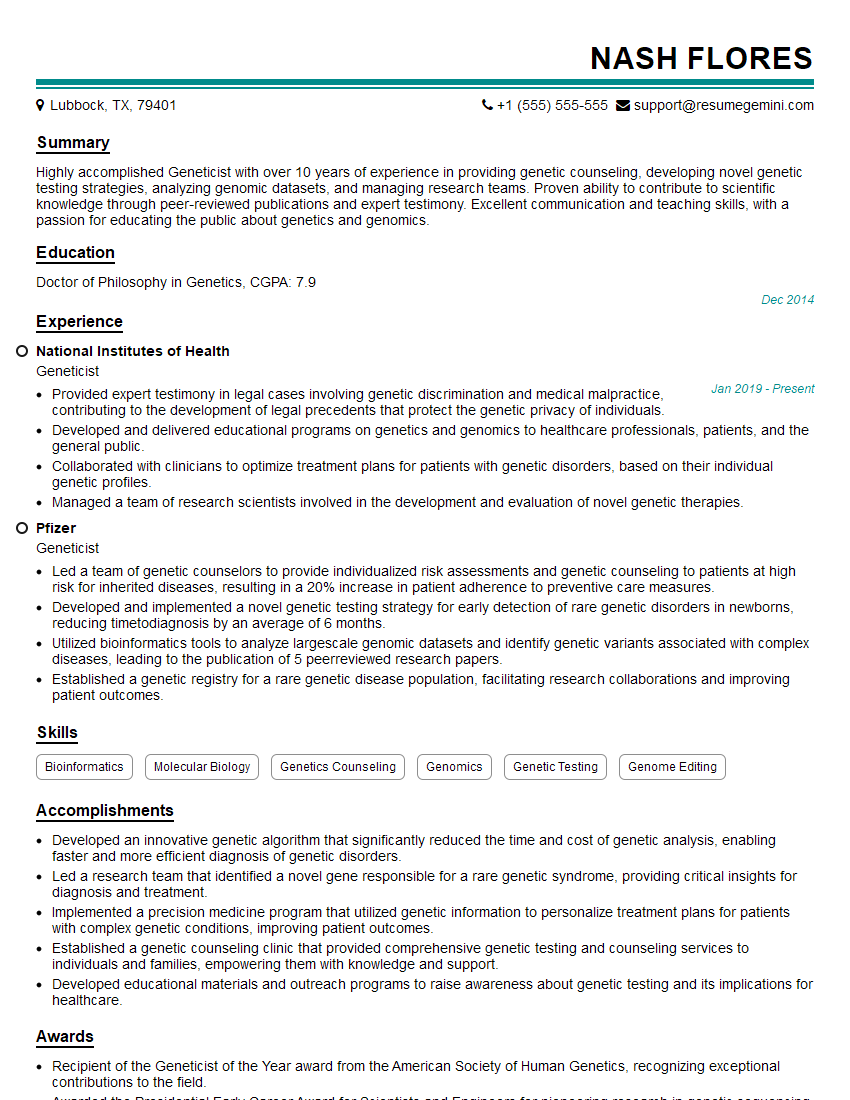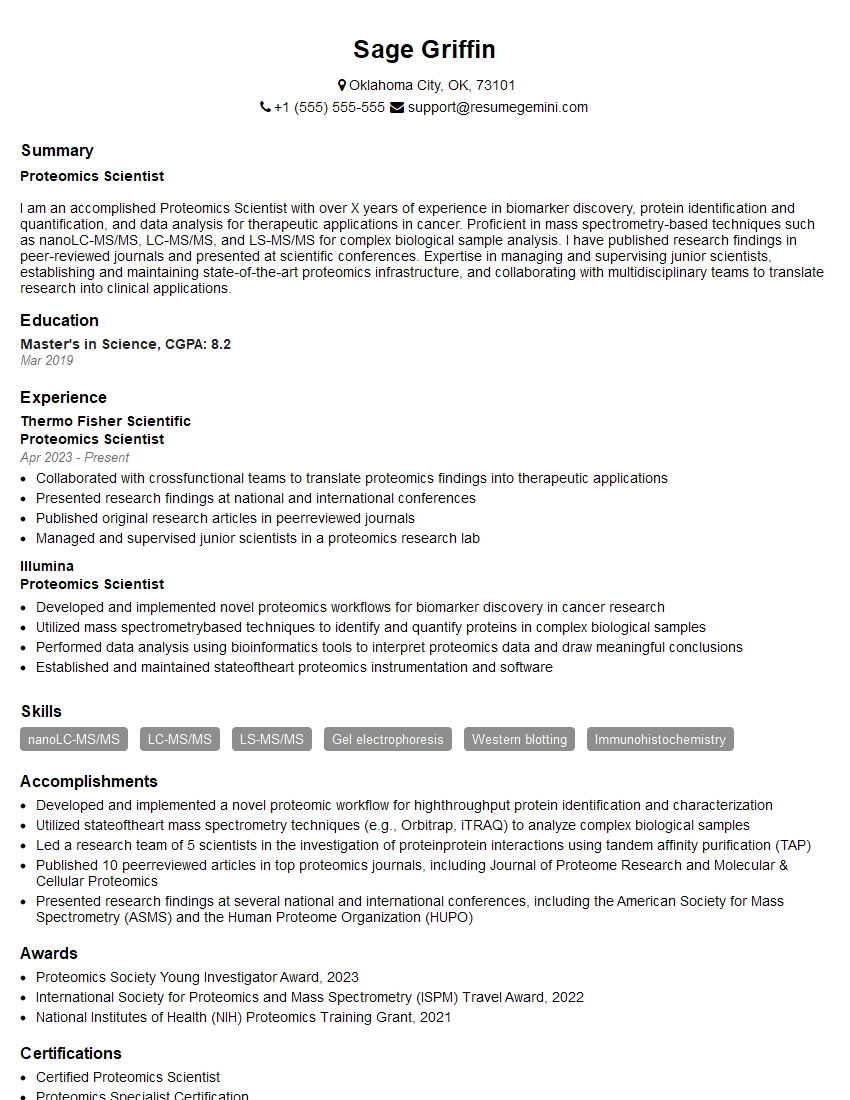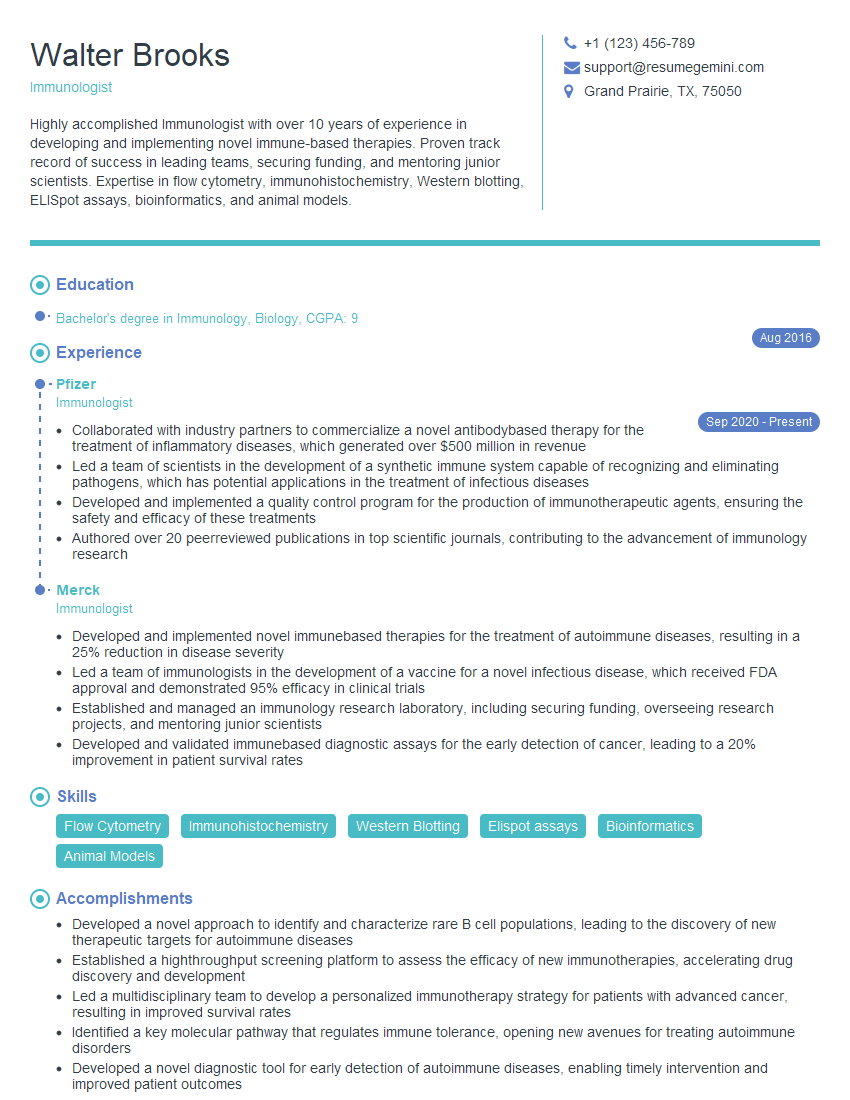Cracking a skill-specific interview, like one for Biotechnology and Genetic Engineering, requires understanding the nuances of the role. In this blog, we present the questions you’re most likely to encounter, along with insights into how to answer them effectively. Let’s ensure you’re ready to make a strong impression.
Questions Asked in Biotechnology and Genetic Engineering Interview
Q 1. Explain the process of PCR (Polymerase Chain Reaction).
PCR, or Polymerase Chain Reaction, is a revolutionary technique in molecular biology that allows us to amplify a specific DNA sequence exponentially. Imagine you have a tiny piece of a puzzle, representing a specific gene, but you need many copies to study it. PCR is like a molecular photocopier, creating millions of copies from that initial fragment.
The process involves several key steps:
- Denaturation: Heating the DNA sample to separate the double-stranded DNA into single strands. Think of it like unzipping a zipper.
- Annealing: Cooling the sample to allow short DNA sequences called primers to bind to their complementary sequences on the single-stranded DNA. Primers act as starting points for DNA synthesis.
- Extension: Raising the temperature again to allow a heat-stable DNA polymerase enzyme (like Taq polymerase) to synthesize new DNA strands, extending from the primers. This is like adding new puzzle pieces.
These three steps are repeated many times (usually 25-35 cycles), leading to an exponential increase in the number of DNA copies. This allows scientists to study genes from even minuscule samples such as a single hair follicle or a drop of blood. Applications range from diagnosing diseases to forensic science to studying ancient DNA.
Q 2. Describe the different types of gene editing technologies.
Gene editing technologies allow us to precisely modify an organism’s genome, like correcting typos in a lengthy document. Several methods exist, each with its strengths and weaknesses:
- CRISPR-Cas9: This is the most widely used and arguably the most revolutionary gene editing tool. It utilizes a guide RNA molecule to direct the Cas9 enzyme to a specific DNA sequence where it creates a double-stranded break. The cell’s natural DNA repair mechanisms then either disrupt the gene (gene knockout) or incorporate a new DNA sequence (gene insertion/replacement). It’s like using a highly precise pair of molecular scissors.
- Zinc Finger Nucleases (ZFNs): These are engineered proteins with zinc finger domains that bind to specific DNA sequences, guiding a nuclease enzyme to cut the DNA at the target site. More complex and less efficient than CRISPR.
- Transcription Activator-Like Effector Nucleases (TALENs): Similar to ZFNs, but utilize different protein domains to target specific DNA sequences. Also less efficient and more expensive than CRISPR.
- Meganucleases: Naturally occurring enzymes that recognize and cut specific long DNA sequences. Their applicability is limited due to the difficulty in engineering them for diverse target sites.
The choice of technology depends on the specific application, target site, and available resources. CRISPR’s simplicity, efficiency, and ease of use have made it the dominant technique in many gene editing applications.
Q 3. What are the ethical considerations surrounding CRISPR-Cas9 technology?
CRISPR-Cas9’s power brings significant ethical considerations. Its precision and relative ease of use raise concerns about:
- Germline Editing: Modifying the germline (sperm and eggs) leads to heritable changes, affecting future generations. This raises profound ethical questions about unintended consequences and altering the human gene pool. Should we be ‘designing’ babies?
- Off-target Effects: While CRISPR is precise, off-target effects (unintended cuts in the genome) can occur, potentially causing harmful mutations. This requires careful design and validation strategies.
- Accessibility and Equity: The technology’s affordability and accessibility are unevenly distributed, leading to concerns about equitable access to its benefits and potential misuse.
- Ethical Oversight and Regulation: The lack of stringent global regulations and ethical oversight increases the risk of misuse and unforeseen consequences. Strong regulatory frameworks are needed to ensure responsible development and application.
These ethical considerations necessitate ongoing discussion, rigorous research, and robust regulatory frameworks to govern CRISPR-Cas9’s application in both research and clinical settings.
Q 4. Explain the central dogma of molecular biology.
The central dogma of molecular biology describes the flow of genetic information within a biological system. It’s a fundamental principle that explains how DNA’s genetic information is used to create proteins, the workhorses of the cell. It can be simplified as:
DNA → RNA → Protein
This process involves:
- Transcription: DNA’s genetic code is transcribed into a messenger RNA (mRNA) molecule. Think of it as creating a working copy from a master blueprint.
- Translation: The mRNA molecule is translated into a protein by ribosomes. This involves reading the mRNA sequence in codons (three-nucleotide units) and linking corresponding amino acids to form a polypeptide chain. This is like constructing a building from a set of instructions.
Exceptions and complexities exist, such as reverse transcription (RNA to DNA), but the central dogma provides a fundamental framework for understanding gene expression and protein synthesis. It’s a crucial concept for understanding many biological processes, from cell differentiation to disease development.
Q 5. What are the different types of cloning techniques?
Cloning involves creating genetically identical copies of a biological entity. Different techniques exist, each with specific applications:
- Gene Cloning: Creating multiple copies of a specific gene. This is usually achieved through PCR or by inserting a gene into a vector (like a plasmid) for replication in a host organism. Think of it as photocopying a single page from a book.
- Reproductive Cloning: Creating a genetically identical copy of an entire organism. This involves somatic cell nuclear transfer (SCNT), where the nucleus of a somatic cell is transferred to an enucleated egg cell. Dolly the sheep is a famous example. This is like creating a whole new book identical to the original.
- Therapeutic Cloning: Creating embryonic stem cells that are genetically identical to a patient. These stem cells can then be used for therapeutic purposes, such as treating diseases. This is like creating a spare part for a machine, identical to the original.
Each cloning technique has ethical and technical considerations, and their applications are carefully evaluated based on ethical principles and potential benefits.
Q 6. Describe the process of protein purification.
Protein purification aims to isolate a specific protein from a complex mixture, like separating a specific type of grain from a mix of grains. This involves several steps:
- Cell Lysis: Breaking open the cells to release the proteins. Methods include sonication, enzymatic lysis, or mechanical disruption.
- Centrifugation: Separating cellular components based on size and density. This removes large debris and organelles.
- Chromatography: Separating proteins based on their properties like size, charge, or affinity. Common techniques include ion-exchange, size-exclusion, and affinity chromatography.
- Electrophoresis: Separating proteins based on their size and charge using an electric field. This provides a visual confirmation of purification.
- Dialysis: Removing small molecules like salts from the protein sample.
The specific steps and techniques used depend on the protein’s properties and the desired purity level. Purified proteins are crucial for research, diagnostics, and therapeutics.
Q 7. Explain the principles of cell culture.
Cell culture involves growing cells outside their natural environment in a controlled setting, like creating a miniature ecosystem in a lab dish. This is essential for various applications, from basic research to drug discovery.
Key principles include:
- Aseptic Technique: Maintaining sterile conditions to prevent contamination by unwanted microorganisms, which can affect cell growth and experimental results.
- Appropriate Culture Medium: Providing the cells with necessary nutrients, growth factors, and hormones to support their growth and proliferation. This medium is carefully balanced to mimic the cell’s natural environment.
- Suitable Incubation Conditions: Maintaining optimal temperature, humidity, and gas composition (e.g., CO2) to mimic the cells’ natural environment. Temperature and CO2 are crucial for cell health and growth.
- Subculturing: Regularly transferring cells to fresh culture medium to prevent overcrowding and maintain cell viability. This is like giving your miniature ecosystem more space to grow.
- Monitoring Cell Growth: Regularly assessing cell density and morphology to ensure healthy growth and detect potential problems. This is like carefully monitoring the health of your miniature ecosystem.
Cell culture techniques vary depending on the cell type and application, and mastering these principles is vital for many biological experiments and applications.
Q 8. What are the different types of bioreactors and their applications?
Bioreactors are vessels designed for carrying out biological reactions involving living organisms or biocatalysts. Different types are chosen based on the scale of production, the organism being cultured, and the process requirements.
- Stirred-tank bioreactors: These are the most common type, utilizing impellers for mixing and aeration. They’re versatile and used for a wide range of applications, from producing antibiotics to cultivating mammalian cells. Think of them as giant, highly controlled mixing bowls.
- Airlift bioreactors: These rely on air bubbles for mixing and aeration. They’re gentler on cells, making them suitable for shear-sensitive organisms. Imagine a bubbly fountain providing both oxygen and mixing.
- Photobioreactors: Designed for photosynthetic organisms like algae, these bioreactors optimize light penetration for efficient growth. They’re crucial for producing biofuels and other valuable compounds from algae.
- Fluidized-bed bioreactors: These use a flow of liquid to suspend solid particles (e.g., immobilized enzymes or cells) for improved mass transfer and efficiency. They are particularly useful for processes requiring high cell densities.
- Packed-bed bioreactors: Similar to fluidized-bed, but the support material is stationary. Ideal for applications involving immobilized enzymes where high substrate concentrations are desired.
The choice of bioreactor depends heavily on the specific application. For example, producing a large quantity of a robust bacterial protein might utilize a stirred-tank reactor, while cultivating delicate mammalian cells for therapeutic applications might necessitate a gentler airlift or perfusion bioreactor.
Q 9. Discuss the applications of bioinformatics in biotechnology.
Bioinformatics plays a vital role in biotechnology by enabling the analysis of large biological datasets, which would otherwise be impossible to interpret manually. It bridges the gap between biology and computer science, allowing researchers to unlock hidden insights from genomic sequences, protein structures, and metabolic pathways.
- Genome sequencing and annotation: Bioinformatics tools assemble DNA sequences, identify genes, and predict their functions. This is fundamental for understanding an organism’s genetic makeup and identifying potential targets for genetic engineering.
- Protein structure prediction and analysis: Predicting protein 3D structure from its amino acid sequence allows researchers to understand its function and design drugs that target it. This is crucial in drug discovery and development.
- Gene expression analysis: Bioinformatics helps analyze gene expression data (e.g., from microarrays or RNA sequencing) to understand how genes are regulated and how they respond to different conditions. This aids in studying disease mechanisms and developing targeted therapies.
- Metabolic pathway modeling: Bioinformatics tools can simulate and analyze metabolic pathways, allowing researchers to optimize metabolic engineering strategies for producing valuable compounds.
- Phylogenetic analysis: This helps understand evolutionary relationships between organisms, assisting in identifying potential sources of useful genes or enzymes.
For example, in drug discovery, bioinformatics helps identify potential drug targets by analyzing genome sequences and protein structures of pathogens. It also aids in the design of effective drugs and predicting their efficacy and side effects.
Q 10. Explain the principles of genetic transformation in bacteria.
Genetic transformation in bacteria involves introducing foreign DNA into bacterial cells, which then incorporate and express the new genetic material. Several methods exist:
- Transformation: This involves making bacterial cells competent (able to take up DNA) and then exposing them to the foreign DNA. Heat shock or electroporation are common methods to increase competence. The DNA is then integrated into the bacterial genome through homologous recombination or maintained as a plasmid.
- Transduction: This uses bacteriophages (viruses that infect bacteria) to deliver foreign DNA into bacterial cells. The phage’s genetic material can accidentally incorporate host DNA. This DNA can then be transferred to another bacteria upon infection.
- Conjugation: This involves direct transfer of genetic material between two bacterial cells via a physical connection. It often happens via plasmids carrying genes that facilitate the transfer. It is common for antibiotic resistance genes to spread through conjugation.
Regardless of the method, successful transformation relies on several factors, including the efficiency of DNA uptake, the stability of the foreign DNA, and the bacterial host’s ability to express the introduced genes. Successful transformation is often confirmed by screening for the expression of a selectable marker, like antibiotic resistance, carried by the transformed DNA.
For instance, in the production of insulin, human insulin genes are inserted into E. coli bacteria using transformation. The bacteria then produce human insulin, which is subsequently purified for therapeutic use. This illustrates the practical application of genetic transformation in biotechnology.
Q 11. Describe the process of DNA sequencing.
DNA sequencing determines the precise order of nucleotides (adenine, guanine, cytosine, and thymine) in a DNA molecule. Several technologies exist, but the fundamental principles remain similar:
- Sanger Sequencing (Chain-termination method): This method uses dideoxynucleotides, which terminate DNA synthesis, in conjunction with normal nucleotides. The resulting fragments of different lengths are separated by electrophoresis and the sequence is determined by reading the order of the fragments. It’s accurate but relatively slow and low-throughput.
- Next-Generation Sequencing (NGS): These technologies involve massively parallel sequencing of millions or billions of DNA fragments simultaneously, greatly increasing throughput and reducing costs. Various NGS platforms exist, such as Illumina sequencing and Ion Torrent sequencing, each employing different chemistries and approaches but with the common goal of rapid sequencing.
The process broadly involves DNA extraction, fragmentation, amplification (often via PCR), sequencing, and data analysis. The choice of method depends on the application; Sanger sequencing is suitable for small projects or confirming specific sequences, while NGS is the preferred method for large-scale projects like whole-genome sequencing.
DNA sequencing is paramount in various applications, from diagnostics and personalized medicine to evolutionary biology and forensics, providing a foundational understanding of the genetic code and its variations.
Q 12. What are the different types of gene expression systems?
Gene expression systems are designed to control the production of a specific protein in a host organism. The choice of system depends on several factors such as the desired protein, the host organism, and the scale of production.
- Bacterial systems (e.g., E. coli): These are widely used because of their rapid growth, ease of genetic manipulation, and relatively low cost. However, they may not be suitable for producing complex proteins requiring post-translational modifications.
- Yeast systems (e.g., Saccharomyces cerevisiae): Yeast systems offer advantages over bacterial systems, capable of performing some post-translational modifications, thus producing more complex proteins. They are useful for the production of secreted proteins.
- Insect cell systems (e.g., baculovirus expression system): These are often preferred for producing eukaryotic proteins that require complex post-translational modifications. They are particularly suitable for proteins that are difficult to express in bacterial systems.
- Mammalian cell systems: These are most similar to human cells and are excellent for producing complex, glycosylated proteins for therapeutic use, even though they are more expensive and more challenging to work with. They ensure proper folding and modification.
- Plant systems: Plants provide a cost-effective and scalable platform for producing therapeutic proteins and other valuable compounds. They can be genetically engineered to synthesize the desired proteins in their leaves, seeds, or other tissues.
The choice of expression system is critical for the successful production of a functional protein. For instance, producing a complex antibody would likely require a mammalian cell system, while a simpler, non-glycosylated protein might be effectively produced in a bacterial system. Careful consideration of the target protein’s characteristics and the system’s capabilities is vital for optimal protein yield and quality.
Q 13. How do you design and execute a scientific experiment?
Designing and executing a scientific experiment involves a structured approach:
- Formulate a hypothesis: Based on existing knowledge and observations, propose a testable statement about the relationship between variables.
- Design the experiment: Define independent (manipulated) and dependent (measured) variables. Determine the sample size, controls (positive and negative), and experimental design (e.g., randomized controlled trial). Consider potential confounding factors.
- Gather materials and equipment: Secure all necessary resources, including reagents, equipment, and software for data analysis.
- Perform the experiment: Follow the experimental design meticulously, recording observations and data accurately. Maintain a detailed lab notebook.
- Analyze data: Employ appropriate statistical methods to analyze the data and test the hypothesis. Visualize data using graphs and charts.
- Interpret results: Draw conclusions based on the data analysis, considering limitations of the experiment. Determine if the hypothesis is supported or refuted.
- Communicate findings: Prepare a scientific report or presentation to share the findings with the scientific community. This often involves peer review and publication in scientific journals.
For example, to test the effect of a new fertilizer on plant growth, the hypothesis might be: “The new fertilizer will increase plant height compared to a control group using standard fertilizer.” The experiment would involve measuring plant height over time for plants treated with the new fertilizer and a control group. Data would then be analyzed statistically to determine if a significant difference in height exists.
Q 14. Explain your understanding of statistical analysis in biotechnology research.
Statistical analysis is crucial in biotechnology research for drawing valid conclusions from experimental data and ensuring the reliability of findings. It helps to identify patterns, quantify uncertainty, and test hypotheses.
- Descriptive statistics: Summarize data using measures of central tendency (mean, median, mode) and dispersion (standard deviation, variance). This provides a basic understanding of the data distribution.
- Inferential statistics: Used to draw conclusions about a population based on a sample. Common techniques include t-tests, ANOVA, and regression analysis. These help determine if differences between groups or correlations between variables are statistically significant.
- Hypothesis testing: Formally test hypotheses using statistical tests. The p-value indicates the probability of observing the results if the null hypothesis is true. A low p-value (typically < 0.05) suggests evidence against the null hypothesis.
- Regression analysis: Investigate relationships between variables, predicting the value of a dependent variable based on the value of independent variables. This is often used in modeling biological processes.
- Bioinformatics tools: Various software packages and tools are used for statistical analysis of biological data (e.g., R, Python with biopython, specialized bioinformatics software). These tools often incorporate advanced statistical methods tailored for biological data analysis.
For example, in a gene expression study comparing gene expression in healthy and diseased cells, statistical tests like t-tests or ANOVA are used to determine if there are significant differences in gene expression levels between the two groups. Regression analysis might be used to explore correlations between gene expression and disease severity. The proper use of statistical analysis ensures the rigor and reliability of the study’s conclusions.
Q 15. Describe your experience with different types of microscopy techniques.
My experience with microscopy techniques spans several modalities, crucial for various biotechnological applications. I’m proficient in bright-field microscopy, a fundamental technique for visualizing stained cells and tissues. This is often my first step in analyzing samples. Beyond this, I have extensive experience with fluorescence microscopy, enabling the visualization of specific molecules using fluorescent labels. This is invaluable for studying protein localization or gene expression. For instance, I’ve used fluorescently tagged antibodies to identify specific proteins within cells, providing critical insights into their function. Furthermore, I’m skilled in confocal microscopy, which allows for high-resolution 3D imaging by eliminating out-of-focus light. This has been crucial in my research involving the three-dimensional organization of cellular structures. Finally, I’ve worked with electron microscopy, both transmission (TEM) and scanning (SEM), offering ultrastructural detail of cells and tissues. For example, using TEM, I’ve analyzed the ultrastructure of bacterial cells expressing a novel recombinant protein. Each technique offers unique advantages, and selecting the appropriate method depends heavily on the research question and the sample being analyzed.
Career Expert Tips:
- Ace those interviews! Prepare effectively by reviewing the Top 50 Most Common Interview Questions on ResumeGemini.
- Navigate your job search with confidence! Explore a wide range of Career Tips on ResumeGemini. Learn about common challenges and recommendations to overcome them.
- Craft the perfect resume! Master the Art of Resume Writing with ResumeGemini’s guide. Showcase your unique qualifications and achievements effectively.
- Don’t miss out on holiday savings! Build your dream resume with ResumeGemini’s ATS optimized templates.
Q 16. What are your skills in data analysis and interpretation?
Data analysis and interpretation are integral to my work. I’m proficient in various statistical software packages, including R and Python, along with specialized bioinformatics tools. My skills encompass a wide range of analyses, from basic descriptive statistics to advanced techniques like regression analysis, ANOVA, and principal component analysis (PCA). For example, I recently used PCA to analyze large gene expression datasets to identify key genes associated with a specific phenotype. I understand the importance of proper data visualization, utilizing tools like GraphPad Prism and other visualization libraries in Python to create clear and informative graphs and charts. Beyond the technical aspects, I prioritize the critical interpretation of results, ensuring that conclusions are supported by sound statistical evidence and biological context. Understanding limitations and potential biases in the data is crucial, and I rigorously address these aspects in my analysis. I also have experience working with image analysis software to quantify data obtained from microscopy experiments. For example, I’ve used ImageJ to quantify the number and size of specific organelles within cells.
Q 17. How familiar are you with good laboratory practices (GLP)?
I’m highly familiar with Good Laboratory Practices (GLP), understanding their importance in ensuring the quality and integrity of experimental data. GLP principles are essential for regulatory compliance, particularly when working on projects intended for submission to regulatory bodies. My experience encompasses proper documentation practices – detailed lab notebooks, accurate recording of procedures, and complete chain of custody for samples. I understand the importance of maintaining accurate calibration records for equipment and using certified reference materials whenever possible. Furthermore, I adhere strictly to appropriate safety protocols, including the proper handling of hazardous materials and the use of personal protective equipment. Maintaining a clean and organized workspace is also paramount to GLP compliance. My experience includes working in GLP-compliant environments in both academic and industry settings, reinforcing my understanding and practical application of these critical principles.
Q 18. Explain your understanding of Intellectual Property (IP) in the biotechnology industry.
Intellectual Property (IP) is crucial in the biotechnology industry. It protects innovations, allowing companies to commercialize their discoveries and fostering further investment in research and development. My understanding encompasses various forms of IP protection, including patents, trademarks, and trade secrets. Patents protect inventions, while trademarks safeguard brand names and logos. Trade secrets, such as proprietary cell lines or unique processes, can also offer significant competitive advantages. I’m aware of the process of obtaining patent protection, including the drafting of patent applications and navigating the complexities of the patent examination process. In my previous role, I was directly involved in discussions regarding IP strategy, helping to assess the patentability of novel findings and ensuring proper documentation to support potential future patent filings. Understanding IP is critical to making informed decisions about research direction and commercialization strategies.
Q 19. Discuss your experience with regulatory compliance in the biotechnology industry.
Regulatory compliance is paramount in the biotechnology industry, varying depending on the specific application of the technology. My experience includes familiarity with regulations related to the development and manufacturing of therapeutic products, including those governed by agencies like the FDA (Food and Drug Administration) in the United States and the EMA (European Medicines Agency) in Europe. This involves understanding the requirements for pre-clinical and clinical testing, Good Manufacturing Practices (GMP) for the production of therapeutics, and the submission of regulatory filings. I’m also familiar with regulations concerning the release of genetically modified organisms (GMOs) into the environment, understanding risk assessment and mitigation strategies. The specific regulations depend greatly on the nature of the research, product, or organism involved. Therefore, staying updated on current regulations and ensuring adherence to these guidelines is crucial for any biotechnology project.
Q 20. How do you troubleshoot problems in a laboratory setting?
Troubleshooting is an everyday aspect of laboratory work. My approach is systematic and involves a series of steps. First, I clearly define the problem and gather all relevant information. This includes reviewing the experimental protocol, checking equipment settings, and assessing any potential sources of error. Second, I generate a list of potential causes. This often involves brainstorming possible explanations and considering both technical and human error. Third, I develop and implement a plan to test each hypothesis. This could involve repeating the experiment with modifications, running control experiments, or using different equipment or reagents. Finally, I analyze the results and document the findings, detailing the resolution and any lessons learned. For example, I once experienced unexpected cell death during a transfection experiment. By systematically investigating potential causes, including reagent quality, transfection protocol, and incubation conditions, I identified the problem to be suboptimal cell plating density, which was corrected by adjusting the protocol. Good record-keeping is essential for tracking the troubleshooting process and preventing similar issues in the future.
Q 21. Describe a situation where you had to work under pressure.
During my PhD, I was involved in a project with a tight deadline for manuscript submission. The experiments were complex and involved multiple steps with potential points of failure. A key piece of equipment malfunctioned two weeks before the deadline. The pressure was significant, as the data from this experiment was crucial for the manuscript. To manage the situation, I immediately contacted the equipment vendor for repair, while simultaneously exploring alternative experimental approaches. I prioritized the most critical experiments and worked extended hours, collaborating closely with my colleagues to expedite data collection and analysis. We successfully completed the essential experiments using alternative methods, enabling the timely submission of the manuscript. This experience taught me the importance of efficient time management, resourcefulness, and effective teamwork under pressure.
Q 22. Explain your experience with different types of cell lines.
My experience encompasses a wide range of cell lines, from immortalized cell lines like HeLa and HEK293, frequently used in research due to their ease of culture and rapid proliferation, to primary cells, such as those derived directly from tissues, which offer a more physiologically relevant model but are more challenging to work with. I’ve also worked extensively with induced pluripotent stem cells (iPSCs), which are fascinating because of their ability to differentiate into various cell types, opening doors for disease modeling and regenerative medicine. Each cell line presents unique characteristics regarding growth conditions (media type, serum concentration, temperature), sensitivity to various treatments, and genetic stability. For instance, HeLa cells are notoriously robust, whereas primary neurons are extremely fragile and require specialized handling. Understanding these nuances is crucial for successful experimental design and interpretation.
In one project, we compared the response of HeLa and primary lung epithelial cells to a novel drug candidate. The HeLa cells showed a significantly different response profile, highlighting the importance of utilizing appropriate cell lines to accurately reflect in vivo conditions. Another project involved differentiating iPSCs into cardiomyocytes to study the effects of genetic mutations on cardiac function. This experience allowed me to refine my techniques in cell culture and significantly broadened my understanding of cell biology.
Q 23. What are your skills in using laboratory equipment and instrumentation?
My expertise extends to a broad spectrum of laboratory equipment, including PCR machines (both real-time and conventional), cell culture incubators and CO2 incubators, flow cytometers, confocal microscopes, automated liquid handling systems, and various electrophoresis systems (agarose and PAGE). I am proficient in operating and maintaining these instruments, ensuring accurate and reproducible results. For example, I’m adept at optimizing PCR protocols to achieve high specificity and sensitivity, troubleshooting issues with cell culture contamination, and analyzing complex flow cytometry data. I also have experience with more specialized equipment, such as next-generation sequencing platforms, though my hands-on experience is more focused on downstream data analysis.
In one instance, a crucial experiment was delayed due to a malfunctioning centrifuge. My ability to quickly diagnose the problem (a faulty rotor) and troubleshoot it, prevented significant project delays, showcasing my practical problem-solving skills within a laboratory setting.
Q 24. Describe your proficiency in various molecular biology techniques.
My molecular biology skillset is extensive, encompassing DNA and RNA extraction and purification, PCR, qPCR, cloning, gene expression analysis (Northern blotting, RT-PCR), protein expression and purification, Western blotting, CRISPR-Cas9 gene editing, and various other techniques. I’m comfortable with both basic and advanced methods, and I am adept at adapting techniques to different experimental designs.
For instance, I have successfully used CRISPR-Cas9 technology to generate gene knockouts in cell lines to investigate gene function. This involved designing guide RNAs, transfecting cells with CRISPR-Cas9 constructs, and validating the gene knockout through various techniques such as PCR and Western blotting. My experience also includes optimizing protocols for specific genes or cell types, demonstrating my ability to troubleshoot and adapt existing methods to solve specific research problems.
Q 25. Explain the role of quality control in the biotechnology industry.
Quality control (QC) is paramount in the biotechnology industry, underpinning the reliability and safety of products and research findings. It involves implementing rigorous processes and standards at every stage, from sample collection and processing to data analysis and product release. This includes proper documentation, appropriate use of controls (positive and negative) in experiments, calibration of equipment, verification of reagents, and strict adherence to Good Laboratory Practices (GLP) or Good Manufacturing Practices (GMP), depending on the context (research versus commercial production). Failure to maintain robust QC can lead to inaccurate results, wasted resources, or, in the case of therapeutics, potentially harmful consequences.
For example, in cell culture, rigorous QC involves regular testing for mycoplasma contamination, a common contaminant that can significantly affect experimental results. In a previous role, I implemented a new QC protocol which reduced contamination rates significantly, improving the reliability of our research. Furthermore, regular calibration and maintenance of laboratory equipment are critical to ensuring data accuracy and consistency.
Q 26. Explain your experience in writing scientific reports and publications.
I have extensive experience in writing scientific reports and publications. I am proficient in structuring manuscripts according to established guidelines (e.g., IMRaD format), clearly presenting research findings, and interpreting data using appropriate statistical analyses. I can effectively communicate complex scientific concepts in a concise and engaging manner to diverse audiences, including scientists, funding bodies, and the public. I am familiar with various publication platforms and the peer-review process. I’ve been involved in drafting and revising manuscripts, preparing figures and tables, and responding to reviewers’ comments.
In my previous role, I was the lead author on a publication in a high-impact journal, detailing a novel drug delivery system. This involved not only conducting the research but also organizing and writing the manuscript, a process which honed my communication and critical thinking skills.
Q 27. Discuss your familiarity with various software used in bioinformatics and data analysis.
My bioinformatics skills encompass a range of software and tools for data analysis and interpretation. I’m proficient in using various sequence alignment programs (e.g., BLAST, ClustalW), genome browsers (e.g., UCSC Genome Browser, Ensembl), and statistical software packages (e.g., R, Python with biopython libraries) for analyzing genomic and transcriptomic data. For example, I’ve used R to perform statistical analysis on microarray data, identifying differentially expressed genes and visualizing the results. I’m also experienced in using databases such as NCBI GenBank and UniProt for retrieving and analyzing biological data. I understand the importance of data quality control and validation in bioinformatics analysis.
In one project, I used Python and bioinformatics tools to analyze next-generation sequencing (NGS) data to identify genetic variations associated with a specific disease. This involved data cleaning, alignment, variant calling, and annotation – a complex workflow requiring significant computational and analytical skills.
Q 28. Describe your understanding of different types of gene therapy approaches.
My understanding of gene therapy approaches includes various strategies, broadly categorized into in vivo and ex vivo methods. In vivo approaches involve directly delivering therapeutic genes into the patient’s body, typically using viral vectors (e.g., adeno-associated viruses, adenoviruses, lentiviruses) or non-viral methods (e.g., lipid nanoparticles). Viral vectors offer high transfection efficiency, while non-viral methods generally pose lower immunogenicity risks but may have lower efficiency. Ex vivo methods involve modifying a patient’s cells outside the body, then reintroducing them after therapeutic gene modification. This approach is often used for gene editing therapies using tools like CRISPR-Cas9, to correct genetic defects in patient’s cells before re-introduction. Different approaches are selected based on the target disease, ease of access to the target tissue, potential for off-target effects, and safety considerations.
For example, gene therapy for inherited retinal diseases frequently uses viral vectors to deliver corrective genes directly to the retina. In contrast, CAR T-cell therapy, a promising cancer treatment, is an example of an ex vivo approach where immune cells are genetically engineered to target cancer cells more effectively.
Key Topics to Learn for Biotechnology and Genetic Engineering Interview
- Molecular Biology Fundamentals: DNA replication, transcription, translation, gene regulation, and their applications in biotechnology.
- Recombinant DNA Technology: Cloning, PCR, gene editing (CRISPR-Cas9), and their applications in disease treatment and genetic modification.
- Genetic Engineering Techniques: Transformation, transfection, viral vectors, and their use in producing therapeutic proteins and genetically modified organisms (GMOs).
- Cell Culture and Tissue Engineering: Principles of cell growth, differentiation, and tissue engineering techniques for regenerative medicine and drug discovery.
- Bioinformatics and Genomics: Analyzing large biological datasets, genomic sequencing, and their application in understanding disease mechanisms and developing personalized medicine.
- Bioprocess Engineering: Scale-up of bioprocesses, fermentation, downstream processing, and quality control in biopharmaceutical production.
- Immunology and its Applications in Biotechnology: Antibody engineering, immunotherapy, vaccine development, and understanding immune responses to genetic modifications.
- Ethical Considerations in Biotechnology and Genetic Engineering: Understanding the societal implications of genetic engineering, gene therapy, and GMOs, and the importance of responsible innovation.
- Problem-solving approaches: Troubleshooting experiments, data analysis and interpretation, critical thinking, and communication of scientific results.
- Practical Applications: Discuss real-world examples of how these concepts are used in various fields like pharmaceuticals, agriculture, diagnostics, and environmental remediation.
Next Steps
Mastering Biotechnology and Genetic Engineering opens doors to exciting and impactful careers in diverse fields. A strong foundation in these areas is crucial for career advancement and securing your dream role. To significantly enhance your job prospects, create an ATS-friendly resume that highlights your skills and experience effectively. We highly recommend using ResumeGemini, a trusted resource, to build a professional resume that stands out. ResumeGemini provides examples of resumes tailored to Biotechnology and Genetic Engineering to guide you through the process. Take the next step towards your ideal career by crafting a compelling resume that showcases your expertise.
Explore more articles
Users Rating of Our Blogs
Share Your Experience
We value your feedback! Please rate our content and share your thoughts (optional).
What Readers Say About Our Blog
good
